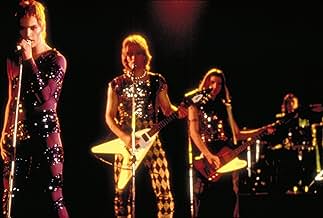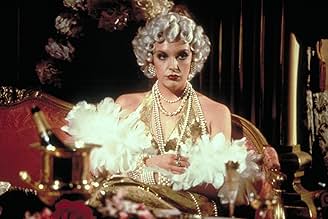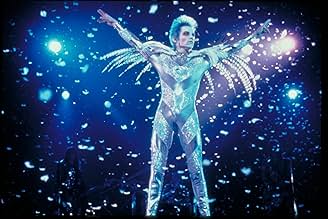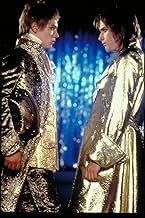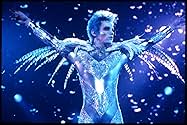Nel 1984, il giornalista britannico Arthur Stuart indaga sulla carriera della superstar degli anni '70 Brian Slade, che è stato fortemente influenzato nei suoi primi anni dal cantante americ... Leggi tuttoNel 1984, il giornalista britannico Arthur Stuart indaga sulla carriera della superstar degli anni '70 Brian Slade, che è stato fortemente influenzato nei suoi primi anni dal cantante americano duro e ribelle Curt Wild.Nel 1984, il giornalista britannico Arthur Stuart indaga sulla carriera della superstar degli anni '70 Brian Slade, che è stato fortemente influenzato nei suoi primi anni dal cantante americano duro e ribelle Curt Wild.
- Regia
- Sceneggiatura
- Star
- Candidato a 1 Oscar
- 4 vittorie e 12 candidature totali
- Wilde Housemaid
- (as Maraid McKinley)
Recensioni in evidenza
It's not a masterpiece, but damned if the cast members don't put their all into the roles. I recommend it, but mind you, this is NOT a fluffy, "Almost Famous"-style look at '70s music; there are some shocking things here.
i loved the camp, outfits, and excesses, and was unexpectedly moved by the story. using a queer, ex-fan reporter to frame the movie--so as to emphasize the effect that this bi-positive bi-posing rock star had on queer kids, and how upsetting his betrayal of them was--worked brilliantly. the use of arty-fairydust moments to capture the importance of fantasy to this scene worked wonderfully. i really appreciated jack fairy, as a character and as a link from glitter to the drag scene--this is not usually acknoledged. and whenever the movie veered too far into preciousness, the iggy pop/kurt wild character showed up to redeem it. his origin story--18 months of electroshock after being caught having sex with a boy--was a much-needed dose of reality in the midst of the glitter. and whenever the movie needed testosterone and directness, he appeared to supply it.
well, i think it's pretty clear that i'm the demographic for this movie--i'm the right age, i'm a fag, and i love both punk and glitter. but my straight boyfriend adored it too. if you ever enjoyed glitter or punk, keep an open mind & check it out, i think you'll like it. even if you don't, you can always look at the pretty outfits.
At the end of the film, when Arthur Stuart sits to have a drink with Curt Wylde (Oh look! A play on Oscar!, Wylde looks up and tells him that, "The true artist creates beautiful things, and puts none of his own life into them". This is one of the several scenes in which Oscar Wilde is referenced subtly, seamlessly and beautifully.
Curt is not simply Iggy Pop. He is Oscar Wilde. He is the true artist of the crowd, because he creates music without using the art as a form of autobiography.
Brian Slade is Dorian Gray. He invests all of his persona into the public, and into his songs, trapping himself in an expectation. The alter-ego Maxwell Demon is eternal youth. It is the embodiment of Slade in a single moment. Unfortunately, he traps himself, and leaves no room for growth. The shooting accomplishes two things. Slade arranging this pseudo-murder is Dorian gray destroying his portrait. At first Dorian was intrigued, even excited by the changes he saw in the painting. Then it began to wear on him. So with Slade/ Demon. The hoax liberates Slade the way death does Gray. Also, This secures Maxwell Demon a place in history. Brian Slade was a pop-star who was too controversial and too personally naked in his work to have any real longevity. The hype would have faded, and if he changed or grew as a person, that would have meant changing everything about his art (as they were so interlocked) and would have led to cries of "sell out". Either way, he would have faded out and been likely forgotten (the way Britney Spears will hopefully do one day). By enacting this faux death, Slade guarantees Maxwell Demon some form of eternal youth, trading in his career to do so (selling his soul).
There's more, as well. Jerry Devine, for instance, is Lord Henry. Mandy is Sybil Vane. They aren't exact, of course, and there are other veins running through them that make them unique, but one can see the influence.
Beautifully done, and a well paid tribute to the genius of Oscar Wilde!
Lo sapevi?
- QuizThe film was originally supposed to feature some of David Bowie's music, hence the title, which was a Bowie song from the 1970s; however, when Bowie learned that the script for the film was partially based on the unauthorized biographies "Stardust: The David Bowie Story" written by Henry Edwards and Tony Zanetta and "Backstage Passes" written by Bowie's ex-wife Angie Bowie, he threatened the producers with a lawsuit. Bowie's songs were, therefore, not used, and the script was partially re-written to avoid unnecessary resemblance between Bowie and the Bowie-style character Brian Slade.
- BlooperArthur figures out the mystery of what happened to Brian Slade by seeing Shannon on TV. He however had no idea what she looked like so seeing her on TV a decade after the events that led to Brian's "death" could not have happened.
- Citazioni
Brian Slade: Man is least himself when he talks in his own person... Give him a mask and he'll tell you the truth.
- Curiosità sui creditiThe solid background color behind the credits changes several times as they play.
- Colonne sonoreNeedle in the Camel's Eye
Written by Brian Eno and Phil Manzanera
Performed by Brian Eno
Courtesy of Caroline Records, Inc.
I più visti
Dettagli
- Data di uscita
- Paesi di origine
- Sito ufficiale
- Lingue
- Celebre anche come
- Glitter Kids
- Luoghi delle riprese
- Lyceum Theatre, Wellington Street, Covent Garden, Londra, Inghilterra, Regno Unito(Reporting outside at about 6 mins 40 secs in)
- Aziende produttrici
- Vedi altri crediti dell’azienda su IMDbPro
Botteghino
- Lordo Stati Uniti e Canada
- 1.053.788 USD
- Fine settimana di apertura Stati Uniti e Canada
- 301.787 USD
- 8 nov 1998
- Lordo in tutto il mondo
- 1.054.291 USD
- Tempo di esecuzione2 ore 3 minuti
- Colore
- Mix di suoni
- Proporzioni
- 1.85 : 1
Contribuisci a questa pagina



